Secretary of the Navy (SECNAV) Carlos Del Toro announced in mid-July that a future Navajo-class towing, salvage, and rescue ship will be named USNS Billy Frank Jr. (T-ATS 11).
The ship will honor Frank, a Nisqually tribal member and iconic Native American environmental leader and treaty rights activist.
The name selection follows the tradition of naming towing, salvage, and rescue ships after prominent Native Americans or Native American tribes, U.S. Navy officials said in a press release.
Frank was born in 1931, a member of the Nisqually tribe in Washington state. After serving as a military policeman in the U.S. Marine Corps during the Korean War, Frank returned to Washington where he became an electrical lineman and continued to fish on his traditional grounds.
By the 1960s, the local salmon fishery was in decline due to increased sport and commercial fishing. In response, state officials began targeting and arresting Native American fishermen like Frank, blaming the decline in salmon stock on them instead.
Escalating arrests and raids led to protests at the state capitol and “fish-ins” arranged by Frank and others. Over the course of these demonstrations, Frank was arrested more than 50 times and became the face of the movement.
In 1974, the matter was taken up by the Federal District Court in Tacoma. Judge George H. Boldt ruled in favor of the Native Americans for their right to fish in their “usual and accustomed places.”
Frank went on to serve as chair of the Northwest Indian Fisheries Commission for more than 30 years and received the Albert Schweitzer Prize for Humanitarianism and the Martin Luther King Jr. Distinguished Service Award, among other accolades.
He passed away in 2014.
His son, Willie Frank III, serves as the chairman of the tribal council of the Nisqually tribe.
The Navajo-class will provide ocean-going tug, salvage, and rescue capabilities to support fleet operations, Navy officials said.
Navajo-class ships will be capable of towing U.S. Navy ships and will have 6,000 square feet of deck space for embarked systems.



